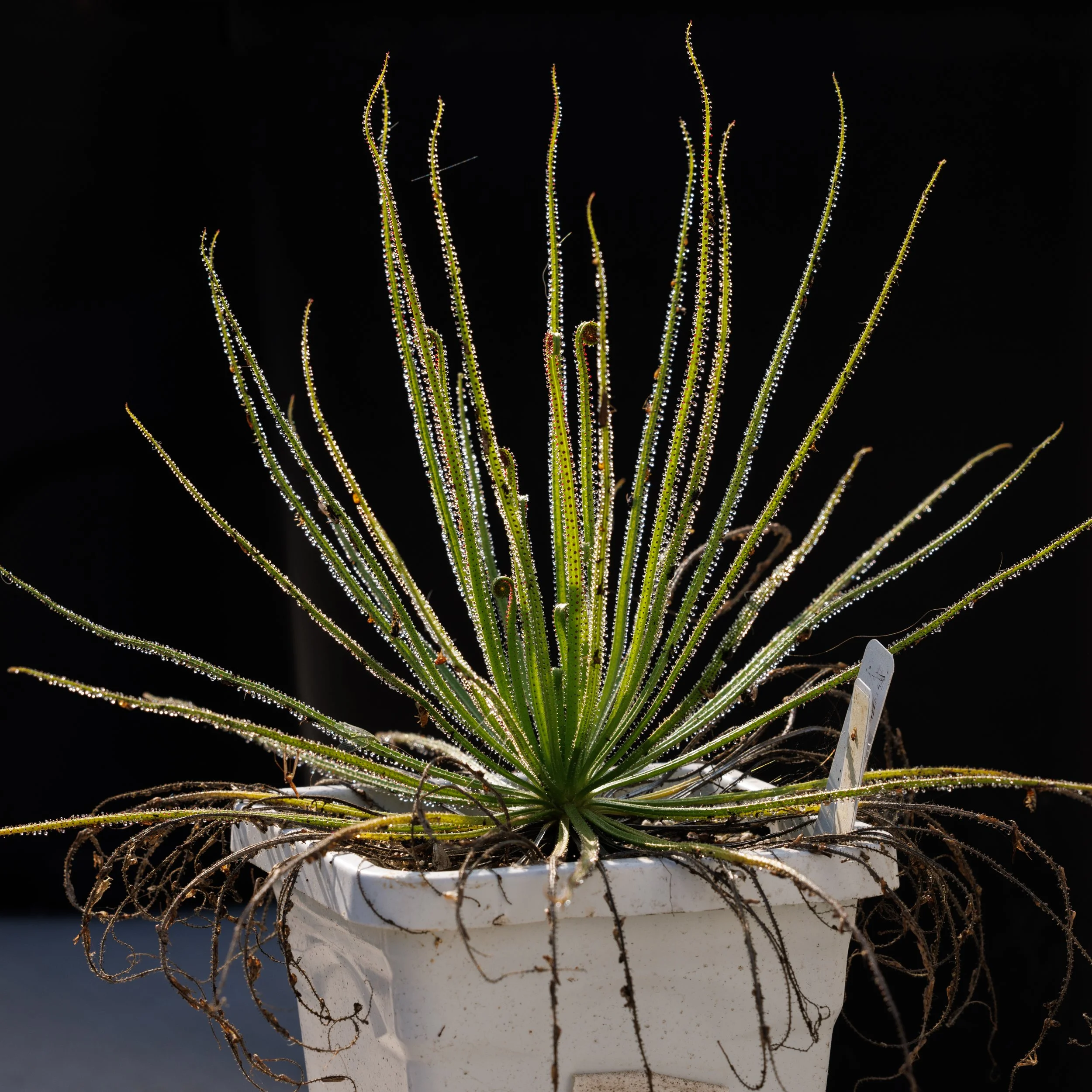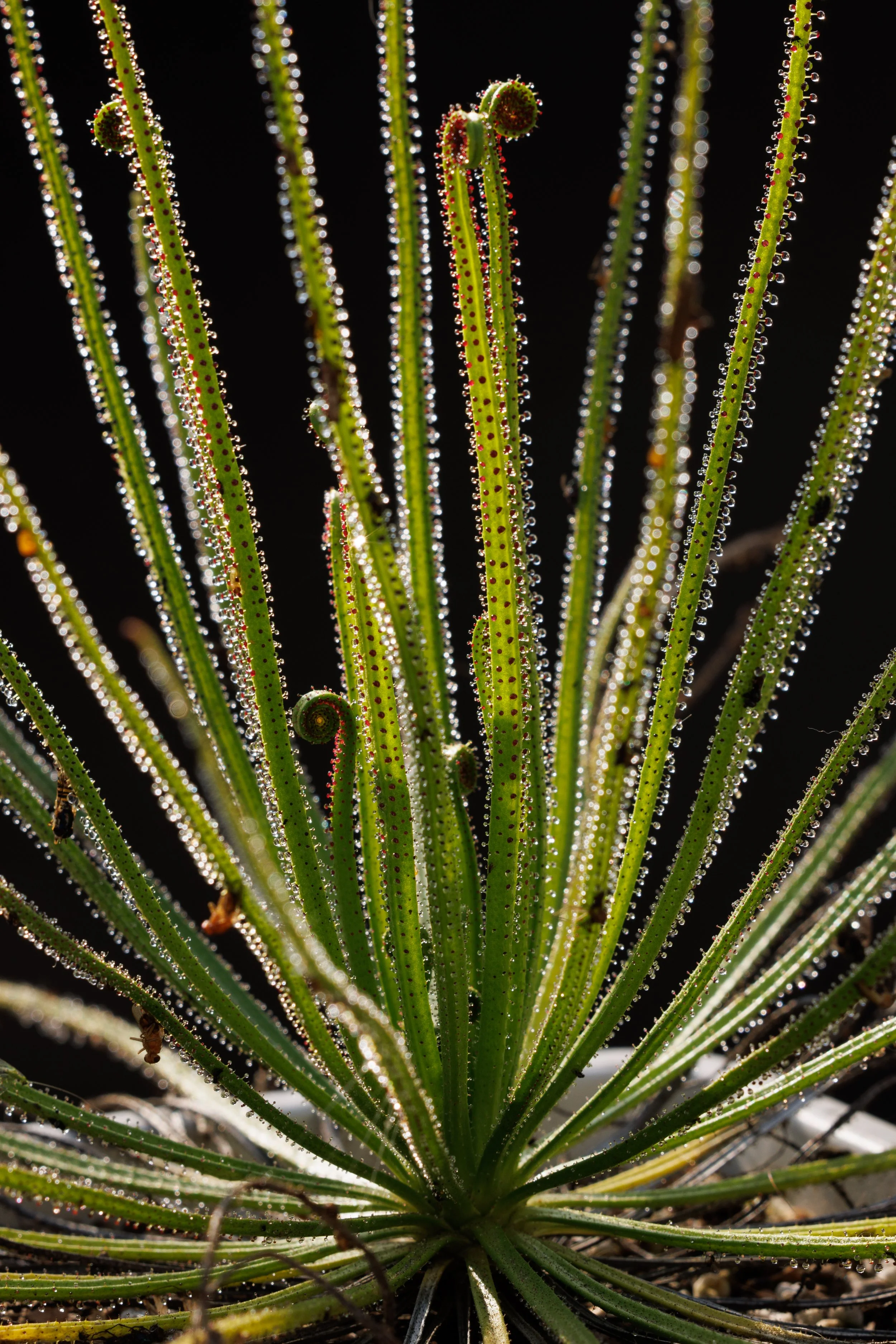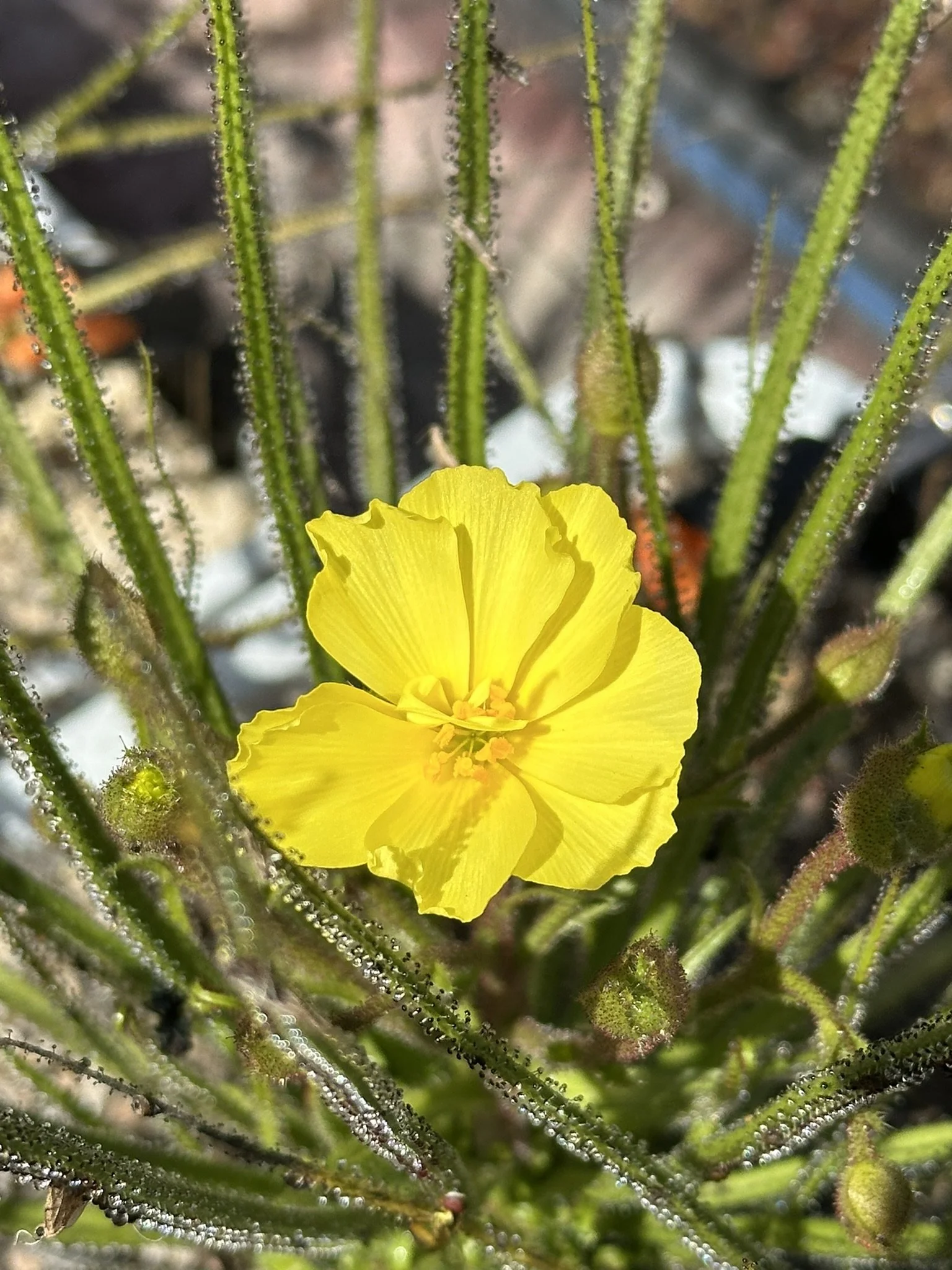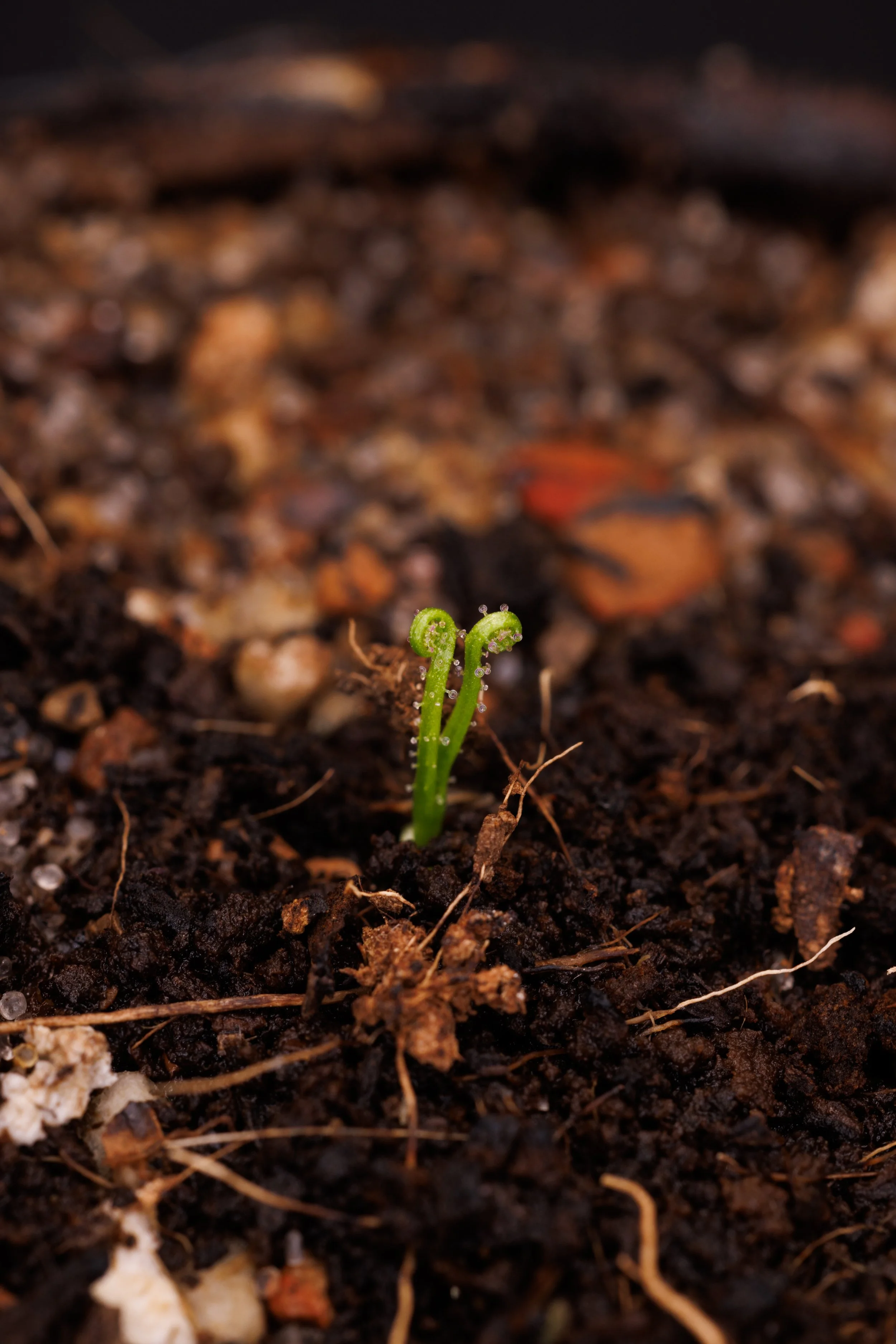Dewy Pine (Drosophyllum) Cultivation











General Info:
Dewy Pines (Drosophyllum lusitanicum) are some of the best flycatchers of all the carnivorous plants while also smelling like honey! They have thin, green leaves with red, mushroom-shaped dew glands that produce a viscous, sticky substance like sundews. However, Dewy Pines are only distantly related to sundews, flytraps, and Asian pitcher plants (Nepenthes). If left outdoors in bright sun, they can catch incredible quantities of insects — sometimes every leaf of the plant is covered in prey. They can rapidly grow to over 1’ in diameter in under a year, maxing out at around 2’ in diameter in a multi-headed, woody shrub.
Looking almost like a glistening tuft of pine needles, Dewy Pines glisten in the sun and emit a sweet, syrupy (and very appetizing) aroma. They require high amounts of sun or intense LED grow lights. Unlike many tropical or bog carnivorous plants, these grow in gravely/sandy, coastal hills in Portugal, Spain, and Morocco that get regular morning fog. Winters are rainy and wet, while summers can have very little precipitation and hot temperatures.
Dewy Pines can be tricky at first, but manageable once their basic needs are met. It can grow from seed to maturity in roughly a year, and then will produce large, brilliant yellow flowers. These will self-pollinate to produce hard black seeds. They are different than other carnivorous plants in their water needs, requiring well-draining, moist soil to thrive. Overly wet soil will cause root rot in mature plants. They prefer wetter soil when at the seedling stage, but once they are a few inches tall, gradually reduce wetness. In early spring or in cooler climates, they may need light watering every few days. In summer or hot climates, they may need top watering every other day (or when extremely hot, every day). The exact watering will depend on the temperature, humidity, sun, soil mix, and pot.
The best soil mix to allow some leniency in watering will be fast draining, but able to retain some moisture for days. I currently use a mix of decomposed granite and perlite. I find that the inorganic mixes lead to better growth and reduce the chances of rot. However, full sun is the most important factor that will make the plant much more resilient to wetter conditions. Signs of overwatering can be abnormal leaf development which develops from root stress. The roots can easily grow well over a foot deep so factor that into your pot choice.
Germination:
Dewy Pine seeds are large, black, and hard and can live for decades in the soil. While having a reputation as difficult to germinate, I find they require mostly patience. They like to be consistently moist to germinate, and the seedlings do best with low humidity, bright sun, and good airflow. Some growers will lightly sand down the edge of the seed to allow water to enter more easily and accelerate germination, but I find this is not essential. When conditions are right, they will germinate in bunches. I have had them germinate at different times of the year, especially in mild weather or after a bit of rain. Treatment with GA3 may help increase germination rates but is not necessary.
Seeds should be planted on top of a granular, mostly inorganic mix that can retain moisture — the seeds want to be consistently moist to germinate. Nestle them into the granular bits to ensure they stay moist and don’t blow away in wind or rain, and put them out in the sun or under very strong LED lights. Either plant them in large, deep pots (>8” depth) as their final home or start them in peat pots that are at least 3” deep.
Once the plant has grown to 2-4” in diameter, plant the entire peat pot into its final pot in a well-draining, inorganic soil. I will put the media in the larger pot until the peat pot can stand at the right depth, then fill in the sides with the rest of the media. While young plants, they can be kept wet on the tray system but should be kept drier as they get larger to avoid roots sitting in water.
Planting Peat Pot:
The Dewy Pine will arrive in a peat pot, wrapped to protect the small seedling. I use larger, deeper peat pots to allow healthier root development before shipping. Carefully and gently unwrap the pot from the packaging. The peat pot will need to be potted into the plant’s final pot since root disturbance is extremely stressful and potentially fatal. Use as large a pot as you can to allow the most room for root growth and longevity, typically a #1 gallon nursery pot is the smallest size that can work for at least a year. Ideally, use an 8”-12” pot that is at least as deep for the roots.
Mix up appropriate soil and fill the new pot, then dig a hole in the center for the peat pot. It is helpful to poke some holes into the peat pot to allow the roots to escape (but not necessary since they can just burst through eventually). Place the peat pot in the hole and fill the soil in around the peat pot all the way to the edge (or even over the edge of the peat pot). The roots will soon grow through the peat pot into the larger pot. Never attempt to repot after this stage. They can be put directly into full sun and should be given good airflow to avoid rot.
Cultivation
Climate: Temperatures of 30F- 90F are fine. They may become stressed during very hot conditions, but can recover once temperatures cool down to below 85F. While they can survive light frost, it is best to keep them above freezing. Low humidity is best.
Lighting: Full sun or at least 40W per sq ft of high quality LED grow lights. Very bright light is essential for survival. These cannot survive with low light – growing them outdoors in full sun is best.
Water: Lightly top water the surface of the pot to maintain moist conditions. Dewy pines want well draining, airy, moist soils (not sitting in trays of water). Give them slightly more water when small (<5” tall) and progressively less water as they grow larger. When first planted, give extra water for a couple weeks as the roots establish themselves in the new soil. Only use distilled, reverse osmosis, or rainwater because tap water is toxic to carnivorous plants due to high mineral content and chlorine.
Soil: A granular, well draining mix like 40% decomposed granite: 60% perlite (maybe a pinch of peat but not sure if necessary). The mix should be well-draining, airy, and inorganic — they are not picky as long as they get enough sun and consistent moisture levels.
Feeding: These can be fed with fish food slurry applied to the underside of the leaves but do best when catching bugs outdoors.
Notes:
Many growers over-water their Dewy Pines out of fear that they are too dry. Err on the side of dryness if you are used to growing other carnivorous plants. Think more like succulents (though don’t let them completely dry out through the whole pot).
These grow best outdoors in several hours of sun where they will catch tons of bugs and nourish themselves. Extremely strong light is essential for long term survival. I have kept them alive under very powerful LEDs (50W/sq ft) but they are far weaker than those in the sun.
The only way to propagate Dewy Pines is by seed. Plants can survive for a few years but are usually limited by pot size. Flowers will easily self-pollinate and fresh seed germinates easily. Seeds can remain viable for decades, but germination rates will decrease.